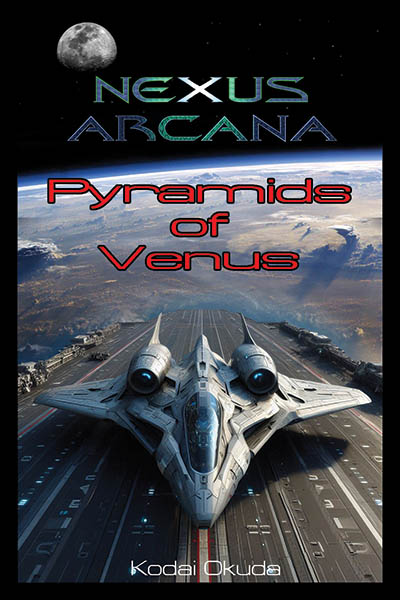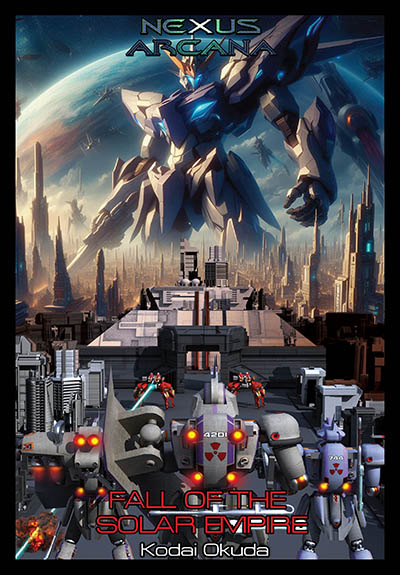Jhararo's All the Galaxy's Warships Vol. 6: Spacecraft Design Concepts (part 3)
by , 08-05-2012 at 05:55 AM (307994 Views)
Welcome to the June issue of Jhararo's All the Galaxy's Warships, the digital database dedicated to the study of mechanical devices, weapons, vehicles, and other machines of the known galactic nations.
This Month's Issue: PART 3 UNSC/Solar Empire "Project Ironclad" spacecraft design concepts of the 1st Interplanetary War era.
* * *
INTRODUCTION TO PART 3
The bulk of the spacecraft used by the UNSC/Solar Empire during the initial phases of the 1st Interplanetary War were based on the Alternative 3 Project space shuttle design of 2040 AD. The craft for this black-ops project had been built in anticipation of conflict with the Solid State Society, and thus were built to facilitate the transfer of key personnel and materials to the fledgling planetoid bases and off-world colonies. Full production of these craft was not begun until after the end of the Asian Pacific Conflict of 2048, after it became clear that the United States of North America was developing a fleet of assault shuttles for use in space.
Thus the vast majority of warships built by the United Nations Space Corps were based on pre-Great War space shuttle and rocket-delivery designs that had been the mainstay of Russian and European space agencies since the 2020s. Instead of working towards building newer designs, the UNSC chose to focus on the upgrade and improvement of existing ones.
The various assault shuttle families of spacecraft (SS-01, CS-01, space fighter (SF-01), and larger scale transport ships were all constructed around conventional spaceship ideas and concepts. Most of the scientists and aerospace engineers of pre-impact Earth thought in terms of what was possible in the 20th and early 21st century. Few had considered what could be possible with mid-21st century breakthroughs and even fewer still pondered what the alien technologies unearthed throughout the solar system could provide.
It was under this atmosphere of conventionally proven aeronautical "wisdom" that the UNSC came face-to-face with types of stellar warships that simply defied any pragmatic explanation in their view: the USSN Juno Class.
* * *
From Great War Era Space Shuttles to "Ironclads"
Having enjoyed near total solar-supremacy after the Earth had been ravaged by the asteroid impact of 2056 AD, the UN Solar Empire fell into a state of complacency fueled by the continued unearthing of alien ruins all over the solar system. The research of the alien data took the highest priority above all other considerations and the resources of the Solar Empire were diverted to support this endeavor, with specific emphasis on finding a way to launch a successful mission to the Alpha Centauri star system.
UNOOSA (United Nations Office of Outer Space Affairs) was charged with the development of an advanced spacecraft design in late 2058 AD using the then new, and experimental plasma drive systems.
This saved the agency from extinction due to the massive budget normally given to the UN Space Corps.
Naturally the resource budget for UNOOSA was inflated considerably from where the agency had been only a few years prior (2055), and thus the UNSC budget reduced down to pre-Great War levels.
During the development phase of the new craft, it became clear to the spacecraft engineers of UNOOSA that the maximum speed their new "interstellar shuttle craft" would be able to travel was a meager .09C (9 percent light speed) and thus would require 52.8 years to travel to Alpha Centauri.
When these findings were presented to the Supreme Soviet Council, the project was scrapped. Immediately UNOOSA put forward a new and radical proposal. This new idea was that of an FTL engine designed using the data garnered from Doctor Xiang's findings at Cydonia on Mars, in order to "jump" to Alpha Centauri.
The Supreme Soviet approved the idea and the Intersection Drive project began.
The scrapped ship design that the UNOOSA research team created did capture the attention of the UNSC Venus force commander. This commander was Grand Admiral Kolchak, and in 2059 he requisitioned for the new craft to be modified into what he called an "Ironclad" style of warship. He chose the name because he wanted a fleet of ships that would give him an ironclad guarantee of continued control of the Inner Sphere of Sol.
* * *
The USSN "Space Cruiser" influence on Ironclad designs
The first combat between a fleet of UNSC assault shuttles and the new Space Cruiser type warships of the USSN took place in mid-2059 at the UNSC fuel refinery base at the planetoid Midway near Earth's moon Luna. The contest was over in a matter of minutes with a blaze of laser cannon and PHELAC weapons fire from the USSN fleet. The US Space Navy force had slaughtered the UN flotilla that guarded the base with no losses. The loss of manpower and materials in such a small period of time caused a rumble to reverberate throughout the upper echelons of the UN Space Corps. Calls were forwarded to the Solar Empire command on Mars immediately.
UNOOSA protested the militarization of the Inner Sphere since the Great War was over, and managed to successfully convinced the Supreme Soviets to deny the request for the construction of large-scale military spacecraft.
Having seen first hand the reports of the battle, Admiral Kolchak demanded that Supreme Commander Zhukov explain to his superiors the gravity of the situation.
The Admiral correctly surmised that large numbers of shuttles with short-range, moderate armor, and light weaponry were simply no match for full scale warships. Kolchak worried that if the UNSC lagged behind the USSN in the development of such craft, the US Space Navy would be able to take control of the Earth sphere and maintain that control with relatively few vessels.
History proved Kolchak correct when the second battle for Midway in late-2059 ended in a brutal defeat for the UN armada, which in addition to its assault shuttles, had lost four ST-52 transport ships acting as spacecraft carriers.
Admiral Kolchak knew something had to be done.
The Byzantine class (pre-Ironclad Prototype)
With their shuttle fleets being decimated at the battle of the planetoid 'Midway' in 2059 by a force of USSN Juno class and Type-59 type "Space Cruisers", Admiral Kolchak demanded a warship more powerful than the AS-03. He was convinced that the Solar Empire's continued obsession with pouring resources into what he called "flights of interstellar fancy" would allow the USSN to build up a formidable space fleet.
The Supreme Soviet Council was not amused, nor did they appropriate funds to construct the vessels he had deemed an absolute necessity.
He therefore took matters into his own hands and ordered the Venus shipyards at Hidalgo to begin construction of a vessel he dubbed the Byzantine class heavy assault shuttle.
The design incorporated everything the Venus Commander felt would give them the advantage against the USSN fleet. A 3500 ton space frigate scale vessel armed with five 120-megawatt laser cannon turrets mounted in strategic positions allowing any four turrets to fire simultaneously forward, port, starboard, or aft: giving the ship an advantage over the Juno. Three forward mounted Lithgear LG-STL-800 tubes with a total of sixty space torpedoes for close combat and planetary bombardment. A 500-megawatt forward firing PHELAC cannon barbette mounted just below the torpedo tubes, and used for anti-warship/spacestation purposes with emphasis on destroying the Juno. Eight high yield ion engines with a maximum velocity of 304,000 miles per hour, and six nuclear dampener generators that were a knock-off of the USSN version used on the Juno. This combination of weapons, armor, propulsion units, and defense shields made the vessel extremely powerful (for it's time), it also set the standard for all subsequent Ironclad type warships.
Pleased, Admiral Kolchak had the Byzantine class under production by the end of 2059 with an output of twelve vessels per year.
In December of 2059 the USSN attempted to capture a fuel and food supply depot some 350,000 miles on the sun-side of the Earth. The Battle of Roselin station ensued and proved the worth of the Byzantine class when three of these new vessels destroyed the USSN battle group of eight Kentucky class assault shuttles, four Type-59s, and one Juno.
The success of the Byzantine class was short lived as the second battle of Roselin station in early 2060 saw the introduction of the USSN Saturn class heavy frigate. One Byzantine was destroyed and three others damaged before the UNSC flotilla was forced to withdraw and surrender the space station.
When news of this defeat reached Admiral Kolchak, he had the Byzantine design team set to work on a new, and larger design.
The Boikii Class (MARK-I Ironclad)
The first Boikii Classships were completed in mid-2061 and used to provide escort for the convoys of ST-52 transport ships that were constantly plagued by Juno class vessels. US Space Navy fleets were increasingly larger within the Earth sphere and many battle groups were spotted within the Kuper depot mining bases of the inner asteroid field. Numerous engagements had taken place throughout the Inner Sphere, and rumors abounded that the Supreme Soviets were becoming aware of a new type of craft defending their spaceways.
This news troubled the head of UNOOSA, which by 2062 was fully invested in the Intersection Drive project, and had produced a prototype of the engine. The agency feared that Kolchak's unauthorized fleet would soon be viewed as necessary to combat the growing USSN nuisance.
Their fears were unfounded, but nonetheless they used spies to capture video footage of Admiral Kolchak speaking publicly about the need for better living conditions for the proletariat and more economic freedom. Once news of his counter-revolutionary views reached the ears of the Soviet elite, the Admiral was shipped off to the gulag at Deimos and production of both the Boikii and Byzantine class were stopped.
Fate has a way of coming back to haunt people, and this is precisely what took place in 2068 to UNOOSA. Flushed with the success of their new Intersection Drive, and oblivious to the loss of the Earth Sphere, the Supreme Soviets ordered the joint UNSC/UNOOSA team at Alpha Centauri to send back whatever data they found with regard to any alien artifacts found there.
Under secret orders from Supreme Commander Alphonse Zhukov, the UNSC team killed and disposed of the UNOOSA group with them and sent the largest alien warship back to Earth.
In addition, the UNSC tried desperately to recapture the Prodono warship but their fleet of Bizantine, Boikii, and assault shuttles were met by the newly combined EFR and USSN SpaceNavy of Space Cruiser type warships.
The UN defeat was dreadful and as a result the Prodono battleship was lost into the hands of the Earth Federal Republic, and UNOOSA was abolished by Premier Dalltan.
The Harpy Class (MARK-II Ironclad)
The next major development in the Ironclad series of Solar Empire warships was the Harpy Class Heavy Cruiser. This vessel incorporated everything that then Supreme Commander Edric VonStalin envisioned the "Project Ironclad" warships needed to be in order to fight the EFR SpaceNavy. Although the Harpy class was not the first of the Mark-II Ironclads, it was the pinnacle of that generation of Ironclad type spacecraft. It had a purely conventional bulky, block-shaped fuselage, forward mounted bridge section, external aft mounted engine nacelles, and side mounted direct-launch hangars. It's deflector screen generators and armor were typical of the Ironclad type vessels and its weapons were a combination of heavy missile, light torpedo, and medium energy weapons. However, the Harpy also incorporated broadside guns, anti-mecha batteries, and heavy beam cannons. Her sister class of cruiser, the Valkyrie Class, also incorporated many of these design features, but not all of them. It lacked the missile weapons and thus was inferior to that of the Harpy class.
The Harpy class served with distinction during the 1st Interplanetary War and it was this success that led the Solar Empire engineers to design what would become a pivotal spacecraft for all types of Terran vessels. That craft being the first Mark-III Ironclad, the Kiev class.
* * *
The Prodono Alien Warship Threat
The Kiev Class (MARK-III Ironclad)
When the Zhukovists destroyed the UNSC Vesta Mark-I Ironclad fleet in 2072 using Prodono warships, Edric VonStalin demanded the creation of a spacecraft that could contend with the alien vessels.
Solar Empire commanders had nothing with which to counter the firepower of the alien vessels in their existing fleet, and even the Mark-II Ironclads that were being developed would be hard pressed against not only the alien warships, but the newly upgraded EFSN armada as well.
Calls went out for improved ships as the UNSC found itself being routed from the Jovian planets, and barely holding their foothold on the Earth sphere.
Even with the development of "Project Ironclad" Mark-II vessels in 2072, the need for the "Ironclads" caused the UNSC to produce the vessels as quickly as the Solar Empire industrial sector was able to pump them out.
The 1st generation of Ironclads were already obsolete by the end of the year, and the 2nd generation of "Ironclads" were unlikely to prove to be much of a help against Zhukov's newly acquired forces.
VonStalin gave the Supreme Soviets no choice, he demanded they put forward the resources for an even more powerful line of ships and get the craft into production as quickly as possible.
Multiple avenues were taken to meet this requirement. One such avenue was the development of the 3rd generation of Ironclad vessel the Mark-III, which was later dubbed Kiev Class.
This new "Mark-III" or third-generation "Ironclad" warship was essentially a Solar Empire version of a "Space Cruiser" style warship. The 25,000 ton Kiev class space-battleships changed the course of the Earth Space Navy's warship design program causing them to scrap the 20,000 ton "Argentina class" spacecraft carrier begun in early 2073. The Kiev also spurred the creation of the Kurita Class of space-battleship, and numerous other post war vessels that used Kiev as the genesis of their design.
* * *
Conclusion of Part 3
Odd as it may seem, the United States Space Navy was indirectly responsible for the creation of the Solar Empire's Ironclad style of warships. The Juno was the origin of the need for this type of craft and had it not been developed, Admiral Kolchak wouldn't have called for the creation of the first ironclad type vessel to deal with it. Thus, in a round-about way, the Juno was the grandfather of most, if not all, of the modern spacecraft types developed by the Earth powers during the 1st Interplanetary War.











 Email Blog Entry
Email Blog Entry

